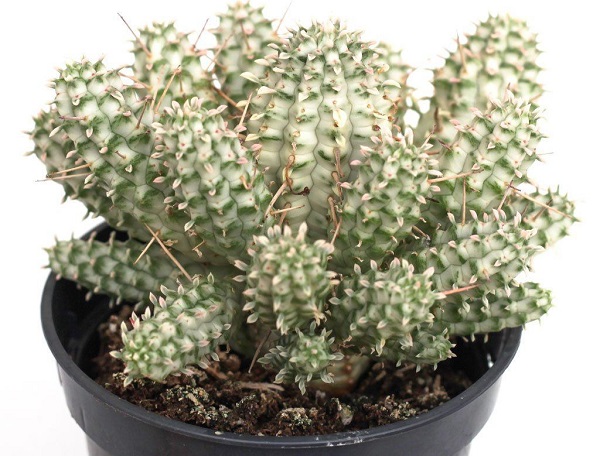

It is suggested to wear eye protection gear and gloves for handling the plant. If ingested, it can cause burns to the mouth, lips, and tongue. While they are botanically distinct, the similar traits of euphorbia and cactus resulted from millennia of adaptations to similarly harsh environments.
#EUPHORBIA CACTUS SKIN#
Skin contact causes severe irritation, redness, and a burning sensation. The wicked sharp thorns of the Euphorbia milii above clearly demonstrate why so many confuse euphorbias with cactus. Exposure to it can cause blindness lasting several days. tirucalli contains a milky sap that is extremely irritating to the skin and mucosa and is toxic.

#EUPHORBIA CACTUS HOW TO#
Learn more at How to Grow and Care for Euphorbia. They tend to grow problem-free, but a few pests and diseases are to be alert for. Rooting hormone is recommended with Euphorbias. This can be tricky because of the exuding sap. These succulents can be grown from seed, but they can be difficult to germinate (or even find). Feed with a half-strength fertilizer monthly if you are growing them in containers or your soil is poor. Add some organic matter or fertilizer to the planting hole. Water deeply, but don't let them sit in wet soil, which can cause root rot. Water whenever the soil is dry several inches below the surface. It may need weekly watering during the summer. Unlike most succulents, Euphorbia does not handle long periods of drought well. They are not particular about soil pH, but they cannot tolerate wet soil. Euphorbias need well-draining soil and lots of sunlight. More die from too much care and watering than from neglect. These plants require a little pampering to become established, but once they are, they are self-sufficient. How to Grow and CareĮuphorbias are very easy to care for. Fruits are tripartite capsules, pale green with a pink tinge, up to 0.5 inches (1.3 cm) in diameter, and covered with soft hairs. They appear during the cooler months of the year. Flowers are yellow, inconspicuous, and carried in clusters at the apex of the short branches or in the angles of the branches. The foliage is denser toward the tops of the stems, leaving the bases bare, giving the plant an Big clusters of chartreuse flower heads last from spring to summer. Blue-green leaves spiral up reddish, downy stems.

When new, the stems bear up to 1 inch (2.5 cm) long leaves that soon drop. Euphorbia characiascomes by its drought and heat tolerance naturally. Stems are fleshy, smooth, green, cylindrical, up to 0.3 inches (0.8 cm) in diameter, and often produced in whorls. Alternatively, you can cut back the flowers before they set seed.African Milk Bush, Finger Euphorbia, Finger Tree, Firestick Plants, Indian Tree Spurge, Milk Bush, Milk Hedge, Naked Lady, Pencil Bush, Pencil Cactus, Pencil Euphorbia, Pencil Tree, Petroleum Plant, Rubber Euphorbia, Rubber Hedge Euphorbia, Rubber Hedge Plant, Sticks on Fire, Fire Stick Plant Synonym(s)Īrthrothamnus tirucalli, Euphorbia geayi, Euphorbia laro, Euphorbia media, Euphorbia rhipsaloides, Euphorbia scoparia, Euphorbia suareziana, Euphorbia viminalis, Tirucalia indica, Tirucalia tirucalli Scientific ClassificationĮuphorbia tirucalli is a succulent shrub or small tree that usually grows up to 16.5 feet (5 m) tall but occasionally may reach up to 33 feet (10 m). Some varieties will self-seed, but you can pot up any unwanted seedlings to share with other gardeners. In smaller gardens, this could be a problem, but you can manage clumps by division every couple of years, replenishing your stock with the younger plants. robbiae will work brilliantly as low maintenance ground cover plants and can be left to naturalise. This can be an advantage – for example, in tricky areas or dry shade, E. Many types of euphorbia are rhizomatous types of plants, and therefore they will spread away from the parent plant. As well as accentuating yellow tones, this plant also works well with silver planting schemes. The Dragon Bones Tree is toxic to humans and pets, especially the sap. The branches aren’t bendable and have spines on their entire surface. Combine with golden grasses and flowering spring bulbs. The Euphorbia Lactea is a cactus-like tropical shrub with several branches and smaller branches extending from the main ones. However, this particular selection is especially effective as part of a broader scheme of yellow flowers and golden plant, as it provides a deep, rich contrast.Įuphorbia ‘Blackbird’ (‘Nothowlee’) with its dark purple foliage, is a great choice for the front of a sunny border or for containers. Many types of euphorbia deliver a startling punch of gold and green that can single-handedly transform a quiet corner of the garden.


 0 kommentar(er)
0 kommentar(er)
